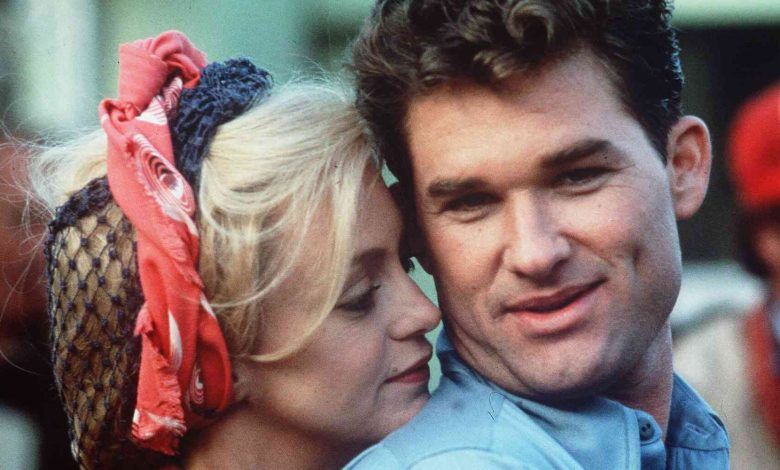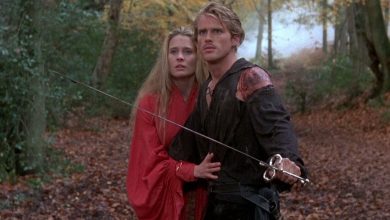This Iconic Real-Life Couple Teamed up Again in This ‘80s Romantic Drama With the Backdrop of War

Although they first met while filming The One and Only, Genuine, Original Family Band all the way back in 1967, Goldie Hawn and Kurt Russell didn’t become a couple until Valentine’s Day 1983, when they were co-starring in Swing Shift. Watching the 1984 release today, it’s clear why Kurt and Goldie have been an item ever since, as their onscreen chemistry is electrifying. A romantic comedy set against the backdrop of World War II, the film acts as a sort of meta-textual look at adult romance, as the audience watches two people fall in love both fictionally and in real life.
‘Swing Shift’s’ Production History Was Anything but Comedic
Image via Warner Bros/Kobal/Shutterstock
Hawn plays Kay Walsh, a California housewife whose husband, Jack (Ed Harris), enlists in the Navy after the Japanese attack on Pearl Harbor. Left on her own for the first time, Kay joins the workforce, getting a job at an armament factory like many other women of her generation. She quickly befriends Hazel Zanussi (Christine Lahti), a nightclub singer who daylights at the factory and has a rocky relationship with club owner Biscuits Toohey (Fred Ward). Kay also starts a flirtation with Lucky Lockhart (Russell), a trumpet player who was deemed unfit for military service and went to work at the factory instead. Although she initially rejects his advances, the two fall in love, but things hit a snag when Jack shows up for a surprise visit and Lucky has a one-night stand with Hazel.
Swing Shift was directed by Jonathan Demme, fresh off the success of his Oscar-winning slice-of-life comedy Melvin and Howard. The script by Nancy Dowd (with uncredited rewrites by Bo Goldman and Ron Nyswaner) was originally centered on the friendship between Kay and Hazel, with Kay’s affair with Lucky as a subplot. Problems arose when Demme showed his first cut to Hawn and her producing partner, Anthea Sylbert, who felt her character faded into the background and that the focus should be shifted to Kay and Lucky’s romance. Demme had no desire to do reshoots, but considering Hawn and Warner Bros. had just scored a big hit with Private Benjamin, the studio took her side. He eventually left before editing was completed and said of the final version, ”I finished the picture one way and then saw it in a new form that I didn’t even recognize.” (The New York Times).
The Version of ‘Swing Shift’ That Exists Is Worth Reappraisal
To compare the two versions of Swing Shift, as Steve Vineberg did for his Sight and Sound essay “Swing Shift: The Unmaking of a Masterpiece?,” is to see what can happen when a director and a star have competing visions of what a film should be. The Demme version is darker and more grounded, with Kay’s feminist transformation taking place amidst a series of side stories with an eccentric ensemble populated by the likes of Holly Hunter, Charles Napier, and Stephen Tobolowsky.
Hawn’s version is more lighthearted in tone, with Kay coming across as the kind of plucky fish-out-of-water heroine she often played. In short, one version is a Jonathan Demme movie in the vein of Something Wild, Married to the Mob, and The Silence of the Lambs, and the other is a Goldie Hawn movie like Protocol, Wildcats, and Bird on a Wire. While most people will likely never see the Demme cut (unless they know how to look for it), the Hawn cut is readily available, and it’s far from a mutilated mess.
Related
See More ...
This Certified Fresh — And Almost Forgotten — Kurt Russell Black Comedy Might Just Be Robert Zemeckis’ Best Film
As opposed to brand new cars.
The version of Swing Shift that exists has echoes of the screwball comedies of the 1940s, with Hawn and Russell displaying the kind of odd-couple chemistry that made Spencer Tracey and Katharine Hepburn such a winning team. Unlike their subsequent collaboration, Overboard, in which Kurt plays a man’s man who brings millionaire Goldie down to size after she suffers a bonk on the head, Swing Shift subverts many of the classic “I’m a man, you’re a woman” stereotypes. Since this is a story of a woman learning to live on her own for the first time, Kay’s affair with Lucky helps move her towards independence, instead of back into subservience. At the same time, to watch Kurt and Goldie banter as Kay and Lucky is to see one of Hollywood’s great couples discover their love for each other, which could only blossom when they were each ready to give the other what they needed to be the best versions of themselves. That might not have been the case in 1967, but it certainly was in 1983.
Source : collider.com



